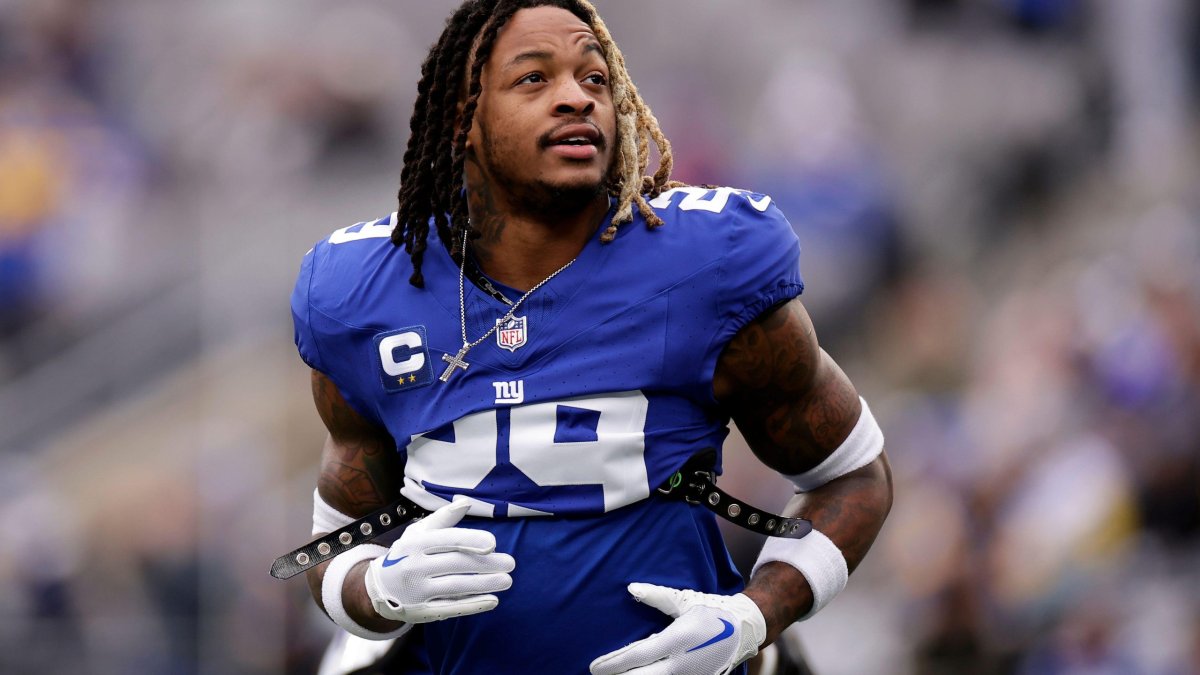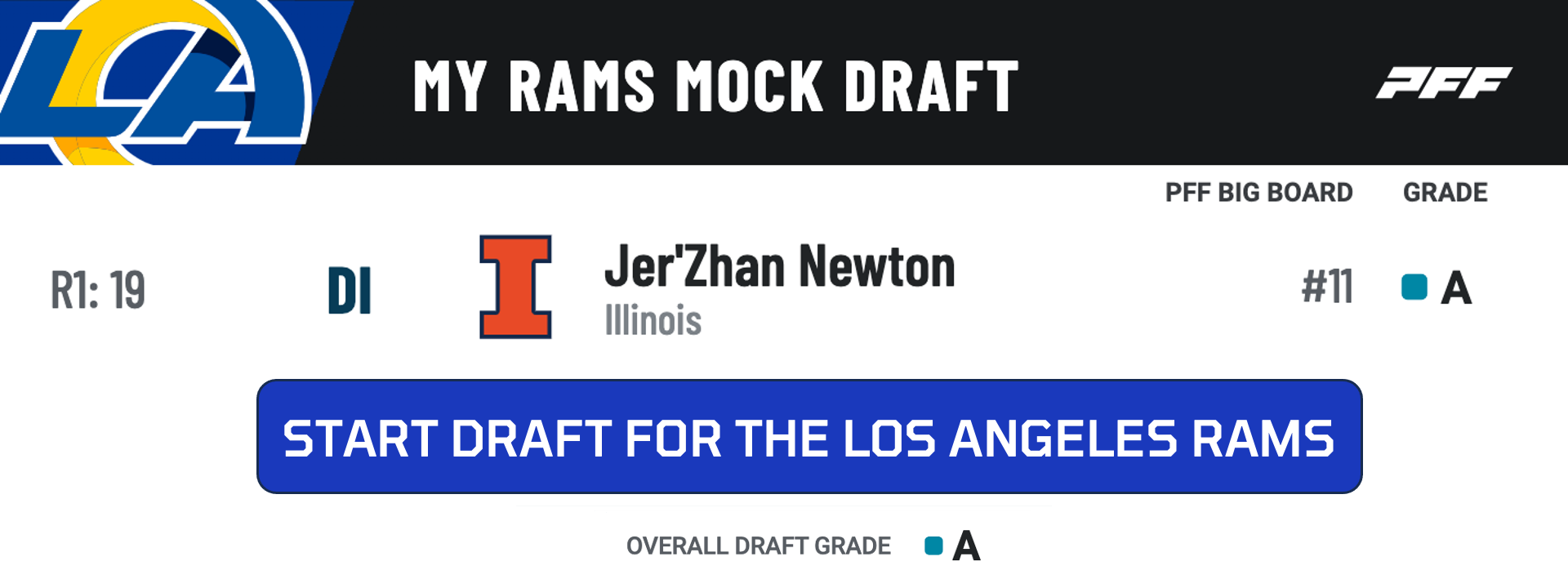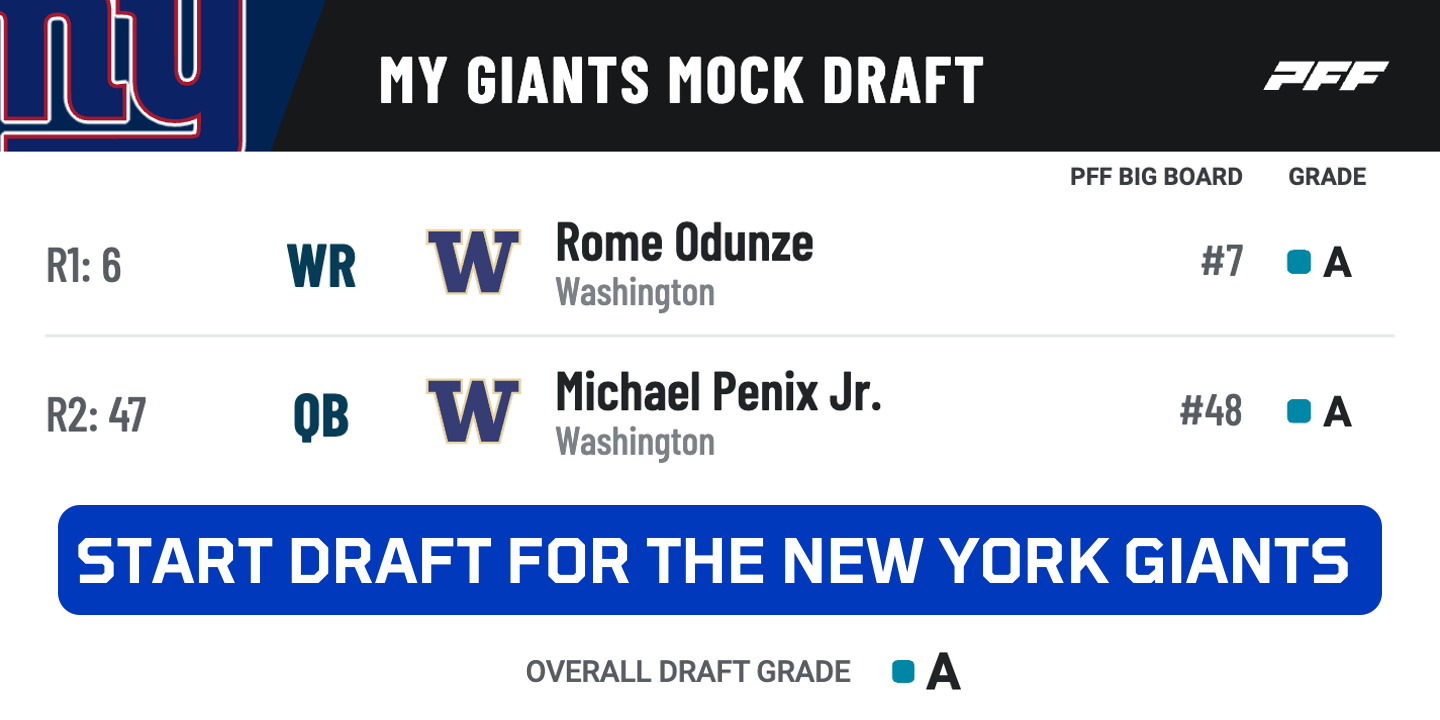• Atlanta Falcons find perfect scheme fit: Kirk Cousins signing with Atlanta was the most consequential move in free agency.
• New York Giants gambled big on Brian Burns: The real question is whether Burns can live up to a lofty contract that pays him more annually than every edge defender not named Nick Bosa. Burns began to look like an elite pass-rusher in 2020, but his production since then has been more good than great, albeit on a struggling Panthers squad.
• Draft and trade for yourself: Try PFF's Mock Draft Simulator — trade picks and players and mock for your favorite NFL team.
Estimated Reading Time: 13 minutes
Click here for more draft tools:
2024 Mock Draft Simulator | 2024 Big Board | 2024 Draft Guide
2024 Player Profiles | 2024 Mock Drafts | NCAA Premium Stats
Free agency is the time for teams to acquire talent who ideally fit their schemes. We’ve seen a ton of moves already made based on connections with coaches while some were made based on certain schematic criteria that meet a team’s needs.
We’ll break down several of those ideal fits as well as a few that are a bit questionable at first glance.
Scheme fits
Atlanta Falcons: QB Kirk Cousins, WR Darnell Mooney andTE Charlie Woerner
The most consequential move in free agency is Kirk Cousins’ arrival in Atlanta. The Falcons ranked dead last in passing grade this past season. Cousins has ranked in the top seven in PFF passing grade in each of the last three seasons. He joins a team with several talented weapons and a top-notch offensive line.
Equally as important is that he likely will continue to play in an offense that he’s run for the vast majority of his career. Cousins has played for Mike and Kyle Shanahan, Gary and Klint Kubiak, Kevin Stefanski and, most recently, Kevin O’Connell.
His new offensive play-caller, Zac Robinson, comes from the same tree after spending the last five seasons in Los Angeles with Sean McVay. Robinson also assisted O’Connell while they were both on McVay’s staff as well. Cousins may miss some early practice reps as he recovers from his torn Achilles, but he will be at an advantage acclimating to an offense that he’s run for nearly his entire career.
Darnell Mooney also enters the fold as a vertical weapon who could bounce back from a tough year in a new environment. Mooney’s production dipped in 2023 primarily due to a lack of usage and Chicago’s quarterbacks struggling to accurately throw the ball downfield.
Across 2021 and 2022, Mooney ranked 24th in the NFL with a 93.0 PFF receiving grade on 10-plus yard throws. That’s in the neighborhood of D.J. Moore, Chris Olave and Amon-Ra St. Brown. Conversely, Falcons wide receivers ranked 28th in 10-plus yard receptions, last in 10-plus yard touchdowns and 20th in receiving grade on such throws. Nearly all of that production came from Drake London, so Mooney’s presence as a potential vertical threat would be welcomed in Atlanta.
Lastly, the Falcons made an underrated signing at tight end, bringing in San Francisco’s Charlie Woerner. He, like Cousins, is very familiar with the Shanahan-style offense. While he’s not going to light up box scores, his contributions up front will make him an important asset in Atlanta.
Woerner finished 2023 with the second-best PFF run-blocking grade among tight ends behind his 49ers teammate George Kittle. He excels in sealing off blockers in zone run schemes from an inline position, something Atlanta needs desperately.
The Falcons’ offensive line is fantastic, but their tight ends ranked last in the NFL in 2023 in PFF run-blocking grade. Kyle Pitts is essentially a wide receiver at this point, as he played less than 22% of his snaps from an inline position in 2023. Woerner’s presence will give the offense a more dynamic balance while allowing Pitts to freely move around the formation.
Chicago Bears: S Kevin Byard
Every defensive playcaller has a trademark scheme. Whether it be blitzes or stunts or disguises, there will be some schematic key that gives them their identity. For Chicago head coach Matt Eberflus, that identity is safety rotation.
During his four seasons in Indianapolis, Eberflus disguised his coverages at the eighth-highest rate in the NFL. While he has run a reasonably similar percentage of these looks with the Bears, their ranking is lower due to a major uptick in disguises league-wide.
The issue in Chicago has been a combination of injuries and poor play. The Bears have not had a defensive back play all 17 games in either of the last two seasons. Consistent communication, especially from the safeties, is a huge key to implementing disguised schemes. Consequently, the Bears have been the lowest-graded defense in the NFL over the last two years when disguising their coverages.
They hope their answer during this free agency period is Kevin Byard, who brings incredible durability having played at least 1,000 snaps in seven straight seasons. You could also call him a master of disguise as he is elite at executing in schemes with safety rotation.
Safety grades with MOF change since 2016 (min. 600 snaps):
| Jessie Bates III | 91.3 |
| Micah Hyde | 90.4 |
| Kevin Byard | 90.3 |
| Justin Simmons | 89.9 |
| Rodney McLeod | 89.8 |
In addition to ranking third overall in these schemes, Byard leads all safeties with a 92.2 PFF run-defense grade. He has often been asked to drop down from a split-safety look and is terrific at supporting the run while also keeping his leverage covering slot receivers and tight ends.
Byard’s sense of timing and leverage when rotating is among the best in the league. Matt Eberflus was looking for someone durable and skilled enough to be able to run his disguised coverages. On paper, it’s a perfect schematic match.
Green Bay Packers: S Xavier McKinney
Coming into free agency, the only safety locked into the Packers 2024 roster was Anthony Johnson Jr. Even if Johnson is a starter in 2024, he profiles as more of a strong safety/slot hybrid.
New defensive coordinator Jeff Hafley needs a true center fielder who can operate as the deep player in single-high defenses. Hafley ran the highest rate of single-high coverages in the FBS during his four years at Boston College.
Xavier McKinney arrives from a New York Giants defense that ran a heavy amount of single-high looks. McKinney led all safeties this past season with a 91.2 coverage grade. A heavy factor in his success is that he ranked second among all safeties with a 91.9 PFF coverage grade in single-high defenses.
The Giants' coverage unit operated at its best when McKinney was lined up as the free safety. Green Bay’s safeties ranked 23rd in the NFL in coverage grade this past season when lined up at free safety.
The Packers still need to add depth across their entire coverage unit, but they found the perfect addition to their defensive transition under Jeff Hafley.
Minnesota Vikings: EDGE Andrew Van Ginkel
Vikings defensive coordinator Brian Flores runs a unique style of defense. He blitzes more than anybody and finds players who can fluctuate between multiple roles. Among those versatile players are a long line of stand-up edge rushers like Rob Ninkovich, Kyle Van Noy, T.J. Watt, and Alex Highsmith.
Another player of that ilk is Andrew Van Ginkel, whom Flores drafted back in 2019 and is coming off his best season as a pro. The two reunite in Minnesota as Flores continues to quickly rebuild the Vikings defense. Van Ginkel finished 2023 with an elite grading profile, which looks even better if we isolate it to reps from a two-point stance.
Pass rush grades as an outside linebacker, 2023 (min. 50 snaps):
| Trey Hendrickson | 91.1 |
| Andrew Van Ginkel | 90.6 |
| Micah Parsons | 90.4 |
| Za’Darius Smith | 90.1 |
| Bradley Chubb | 86.1 |
Only Trey Hendrickson, an elite pass-rusher in his own right, finished with a higher PFF pass-rush grade than Van Ginkel when lined up as an outside linebacker. Van Ginkel has also proven he can drop into coverage from that spot as he played the second-most coverage snaps of any edge defender last season, earning an excellent 87.3 PFF coverage grade in the process.
Though the Vikings had Danielle Hunter producing as a more traditional defensive end, they ranked 30th in the NFL in PFF pass-rush grade by outside linebackers. D.J. Wonnum and Pat Jones II weren’t giving them enough production to round out that unit.
The Vikings lost Hunter to Houston, but they are likely more well-rounded after picking Van Ginkel along with Jonathan Greenard and Blake Cashman, whose presence, especially, will allow Ivan Pace Jr. to wreak more havoc with his prowess blitzing from the inside.
Brian Flores’ ideal defense involves players who possess both talent and versatility. His familiarity with Van Ginkel brought him a player with plenty of both. Minnesota still has needs at defensive tackle and cornerback, but the Van Ginkel signing adds a dimension to their front seven that they were lacking last season.
Los Angeles Rams: G Jonah Jackson
The Rams’ offensive line suddenly looks close to being a potent unit. Retaining right guard Kevin Dotson was a big win. Steve Avila was a nice second-round pick last season. Tackles Alaric Jackson and Rob Havenstein perform serviceable work in their respective spots.
Now Los Angeles has completed their offensive line puzzle, adding Jonah Jackson. On the surface, paying Jackson a large amount of money might be puzzling, considering he’s coming off his lowest-graded season since his rookie year. This move, though, is about Sean McVay’s new philosophy in the run game.
McVay, a Shanahan protege, has always leaned on outside zone run schemes. However, over the last two seasons, the Rams lead the NFL in man, or duo, run schemes by a pretty wide margin. That change is a major reason why Kevin Dotson became the excellent player that he is now.
McVay realized that his offensive line operated better with this new downhill approach. As a result, the Rams ranked near the top of the league in many key rushing metrics when running man schemes. Signing Jonah Jackson makes them better on two fronts.
The first is that Jackson is an excellent run blocker in these schemes. Since 2020, 71 guards have had at least 100 reps in man run schemes. Jackson’s 77.6 PFF run-blocking grade ranks sixth among those 71 and second among all left guards behind the now-retired Ali Marpet.
Jackson has also been a solid zone blocker throughout his career. The one aspect he struggles with is when he is pulling, but the Rams rarely pull their guards so that can be masked. McVay and the Rams were looking for an excellent downhill run blocker, and they found one in Jackson.
The other element of this acquisition is that Steve Avila is likely to move back to center, where he played the majority of his snaps until his final year at TCU. This may prove to be a prudent move considering his college success at that spot.
Steve Avila‘s college splits:
| Position | Pass Blocking Grade | Run Blocking Grade |
| Center | 75.4 | 83.1 |
| Guard | 83.1 | 67.3 |
Avila’s consistent pass blocking is the primary reason he was drafted early in the second round. He showed, though, at TCU that he was a better run blocker as a center than he was as a guard.
It seems the Rams have found their ideal offensive line alignment. Their change in philosophy and the acquisition of Jackson has allowed them to do so.
Questionable fits
Chicago Bears: RB D’Andre Swift
Through the first several weeks of the 2023 season, D’Andre Swift finally looked like a back who was living up to his lofty draft status. As the season progressed, Swift seemed to revert to his previous form.
| Metric | Week 1-5 | Week 6-WC |
| Rushing Grade | 81.6 | 61.6 |
| Yards per Carry | 5.7 | 4.0 |
| Missed Tackles Forced | 18 | 27 |
| Yards after contact per attempt | 2.87 | 2.23 |
Swift’s 61.6 PFF rushing grade from Week 6 onward was the lowest out of 37 running backs with at least 100 carries. His yards after contact per attempt figure was also the second-lowest amongst that group.
At the crux of Swift’s issues could be an awkward match with Shane Waldron’s zone-heavy run scheme. Seattle ran a zone scheme on 60% of their run plays last season. Swift produced just a 68.0 rushing grade on zone runs last year. That’s nearly identical to Swift’s career 67.6 zone rushing grade, which ranks 40th out of 47 backs who have taken at least 200 zone carries since 2020.
With needs at receiver and on defense, it’s likely that the Bears could get similar production from incumbents Khalil Herbert, Roschon Johnson, or a potential draftee on the ground.
Miami Dolphins: C Aaron Brewer
Like many teams across the NFL, the Dolphins’ primary focus should be protecting their franchise quarterback. Three key contributors for Miami’s offensive line entered free agency. One of them, right guard Robert Hunt, just signed a massive deal with the Carolina Panthers.
Another, center Connor Williams, remains on the market and was identified as someone whom Miami should work hard to retain despite his season-ending injury suffered in Week 14. Williams finished 2023 only behind Frank Ragnow in overall PFF grade and run-blocking grade while also carrying the sixth-best grade in pass protection.
Instead, the Dolphins pivoted to Tennessee’s Aaron Brewer, who is a fine run blocker but earned just a 52.5 PFF pass-blocking grade this past season playing center. He graded even lower during the previous two seasons while primarily playing guard. His 28.5 true pass-blocking grade was the sixth-lowest among qualified centers. Meanwhile, Williams, in far fewer reps, owned the sixth-highest grade.
Also questionable is Brewer’s fit in Miami’s zone running game. While he was one of the best gap scheme blockers at his position, his 2023 production and career track record show a zone blocker who is much closer to average. Over the last two seasons, Connor Williams trails only all-world guard Chris Lindstrom in zone blocking grade among all offensive linemen.
As of this writing, Williams is still on the market. He and Brewer both have extensive experience playing guard, so it is still possible that they could play on the same line and succeed. If Miami lets Williams walk, though, they may have taken a step backward.
New York Giants: EDGE Brian Burns
New York signing Brian Burns isn’t a bad move, but it is a massive gamble. The draft compensation sent to Carolina is roughly equivalent to what they got from Seattle in the Leonard Williams trade.
The real question is whether Burns can live up to a lofty contract that pays him more annually than every edge defender not named Nick Bosa. Burns began to look like an elite pass-rusher in 2020, but his production since then has been more good than great, albeit on a struggling Panthers squad.
Brian Burns Grades since 2021 (min. 1000 snaps played):
| Overall Grade | 68.8 (57th/103) |
| Run Defense Grade | 50.2 (89th/103) |
| Pass Rush Grade | 77.5 (32nd/103) |
Burns’ grade profile hasn’t been at an elite level over the past three seasons. While 2023 was his best year since his breakout in 2020, he still ranked just inside the top 40 among edge defenders in overall grade and the top 30 in pass rush grade.
There are some positive signs as Burns' true pass rush grade outperforms his total mark. He also has never played with another edge defender as talented as Kayvon Thibodeaux during his time in Carolina. Lastly, Burns figures to play a lot more in a three-point stance under new defensive coordinator Shane Bowen.
Burns’ career pass rush grade from a three-point stance is far higher than when he is standing up. Over the last couple of seasons, he’s been used, perhaps improperly, primarily as an outside linebacker as opposed to a true defensive end.
Burns is still just 26 years old, so his best days may be ahead of him. The Giants are taking a huge gamble on him based on projection and fit in a more comfortable role. With the massive amount of resources they have invested in their defensive line, they need Burns and Kayvon Thibodeaux to give them elite production.






 © 2024 PFF - all rights reserved.
© 2024 PFF - all rights reserved.